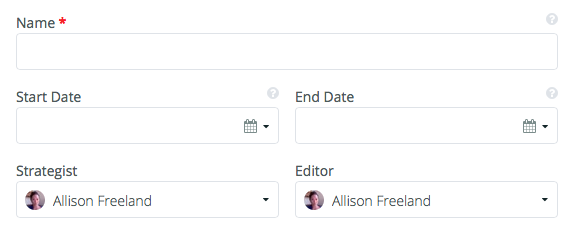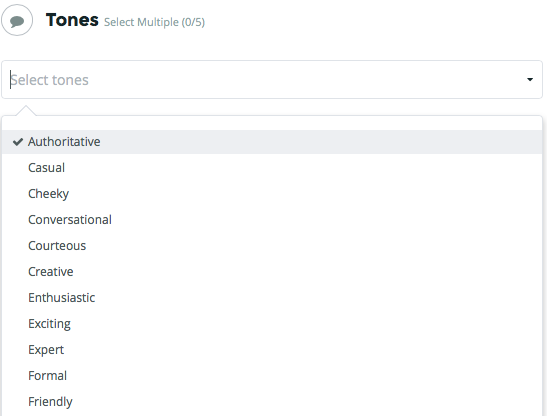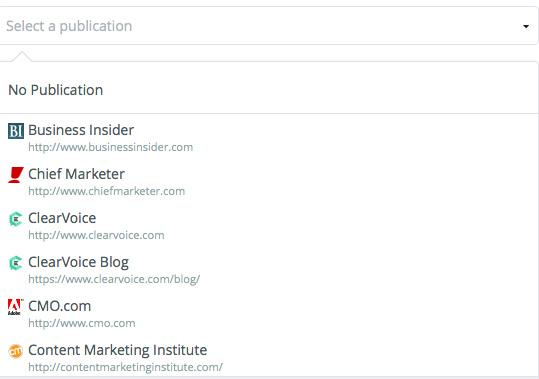Is there a common denominator in successful content campaigns? Yes. Producing high-quality, audience-focused, converting content starts with architecting predefined elements in a content campaign. Like any other form of marketing, your effort prior to dispatching content assignments sets you up for content success down the line. Why? It creates a blueprint for producing and scaling high-quality content.
Internal and external contributors adhere to the same standards, thus producing similar content; your brand’s voice remains consistent and unyielding. Creating campaigns also saves you time. In fact, you can enter editorial guidelines, keywords, publication targets, tones, personas, and team members only once, rather than filling out the information each time you dispatch an assignment. They automatically populate into every assignment within ClearVoice. (And, remember, you can edit fields on the assignment as necessary.)
Content failure strikes when brands shoot from the hip and miss the setup/strategy phase. Creating sporadic content pieces is an immediate customer turnoff because they create a jarring journey and inconsistent brand message.
Complete the following elements to create structure for executing a great content campaign with ClearVoice.
Step 1: Create a Name
Simple as it is, denote the name of your campaign. A campaign can be separated by content type, theme, destination, season, product launch, or anything that makes sense for your brand.
Step 2: Make Your Campaign Time-Bound
Set a start and end date to your campaign. Time-bound campaigns allow you to reach attainable content goals with more ease. (Remember, your start and end times should encompass all areas: strategy, writing, editing, routing, and publishing.)
Step 3: Define Your Team

Step 4: Define Your Editorial Guidelines
Creating consistent editorial guidelines allows you to define desired word counts, how to show numbers, how to capitalize headers and spell out numbers, use punctuation, avoid competitor names, reveal tone, speak to audience, takeaways, linking strategies, and even keyword mapping. Point blank: Editorial guidelines create consistent rules for all content contributors to adhere to. In this day and age, you will likely have both internal (staffed) and outsourced (freelance) contributors on your content team, so completing this “fixed” document on your content’s must-haves is essential for content consistency. You can never assume a content contributor has context about an assignment.
Here’s an example from ClearVoice’s blog:
This post will appear on the ClearVoice blog.
The audience is people on midsize marketing teams (3-10 people) at midsize companies (those with revenue from $10 million to $1 billion annually). These are content strategists, editors, digital marketers and community managers, all the way up to the director of content, chief marketing officer and CEO. They’re looking for ways to improve and optimize their content production and distribution. They don’t need 101-level content; they already know the 101 stuff. Think more advanced, mid-level content.
Our voice is smart, confident and helpful. Our tone is friendly, familiar and approachable. Show us your personality. Give us your passion.
[Need help creating editorial guidelines? Read Hubspot’s “11 Editorial Guidelines Every Business Blog Needs” post.]
Step 5: Add Keywords
Content and SEO are complementary: Your keyword strategy is a critical part of the content process. Include keywords you want mentioned in content assignments. If you need a place to start, use the Keyword Tool within Google Adwords, Moz’s Keyword Explorer, or Wordstream’s keyword planner. While you don’t want to cannibalize each page’s primary keyword target, you can direct contributors to include high-level supporting keywords to include in your copy to support your main-level page’s ranking success.
 Step 6: Define the Target Publication(s):
Step 6: Define the Target Publication(s):
This element offers clarity on where the contributed content will appear. Will the content assignments be hosted on your enterprise’s website, or externally? This helps define this so the content contributors understand where the home for their content is. Here’s an example from ClearVoice’s campaign:
Step 7: Determine the Editorial Tone

Step 8: Develop Personas
Audience data is the most important element that should form the foundation of your content strategy. This element defines whom your brand targets. Fill out general demographics like age, gender, race, marital status, education level, job, geographic location, income range, and even digital usage, then streamline the data to define who your ideal customers would be through a custom persona. Developing personas is critical because it helps you visualize your reader’s values, interests, challenges, and pain points.
For more on the topic, read our great post about personas: How to Create Buyer Personas for Your B2B Marketing.
Parting Words
You need to put strategy before tactics in order to have a successful content campaign. Thankfully content workflow technology like ClearVoice exists to assist you in this process. So, put down those Excel worksheets or pen and paper and get to it!

 Step 6: Define the Target Publication(s):
Step 6: Define the Target Publication(s):


